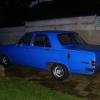Rb25/30 Cr On 98
Announcements
-
Similar Content
-
Latest Posts
-
It's funny, as Ive seen plenty of people use them in cheap builds on YT. And they actually go okay, even though a lot of other maxspeedingrods stuff is terrible. Those turbos seem reliable enough, the only part being, a good quality turbo that is "identical" to it, will out perform it day in and day out. In both a lower boost threshold, and the ability to flow more air at the same boost pressure. As a cheap cheap replacement, not a terrible choice. For cheap and shouldn't blow in a day, not terrible (like other eBay/Temu turbos) for low cost and still decent performance, that's where the question comes in to play from the results I've seen. I'd actually find it hilarious to buy one, and strap it to a paddock basher or some other cheap as POS originally NA car, and send it to the moon!
-
The maxpeedingrods turbo is cheap and bolts on to stock parts. I think you just need a bigger silicone coupler for the intake. Its a cheap china turbo, but it's been running on mine for almost 3 years at 16-19 psi.
-
What do they look like right after you've tried to start it with everything connected? Also post photos of what they actually look like.
-
Also wanted to say, my new spark plugs are blackened looks like it's very rich. I have splitfire coilpacks but stock coilpack loom and ignitor. I tried directly grounding the ignitor ground to body as well.
-
What do the spark plugs look like after you tried to start it with everything connected?
-








Recommended Posts
Create an account or sign in to comment
You need to be a member in order to leave a comment
Create an account
Sign up for a new account in our community. It's easy!
Register a new accountSign in
Already have an account? Sign in here.
Sign In Now